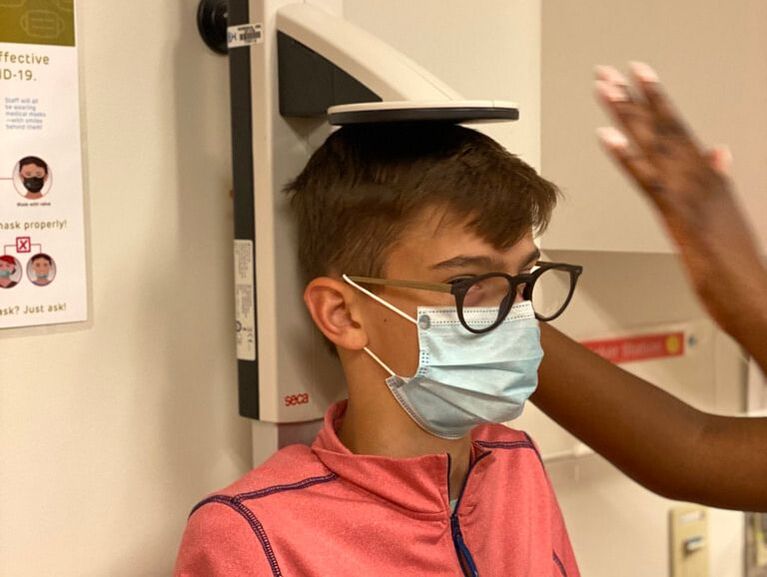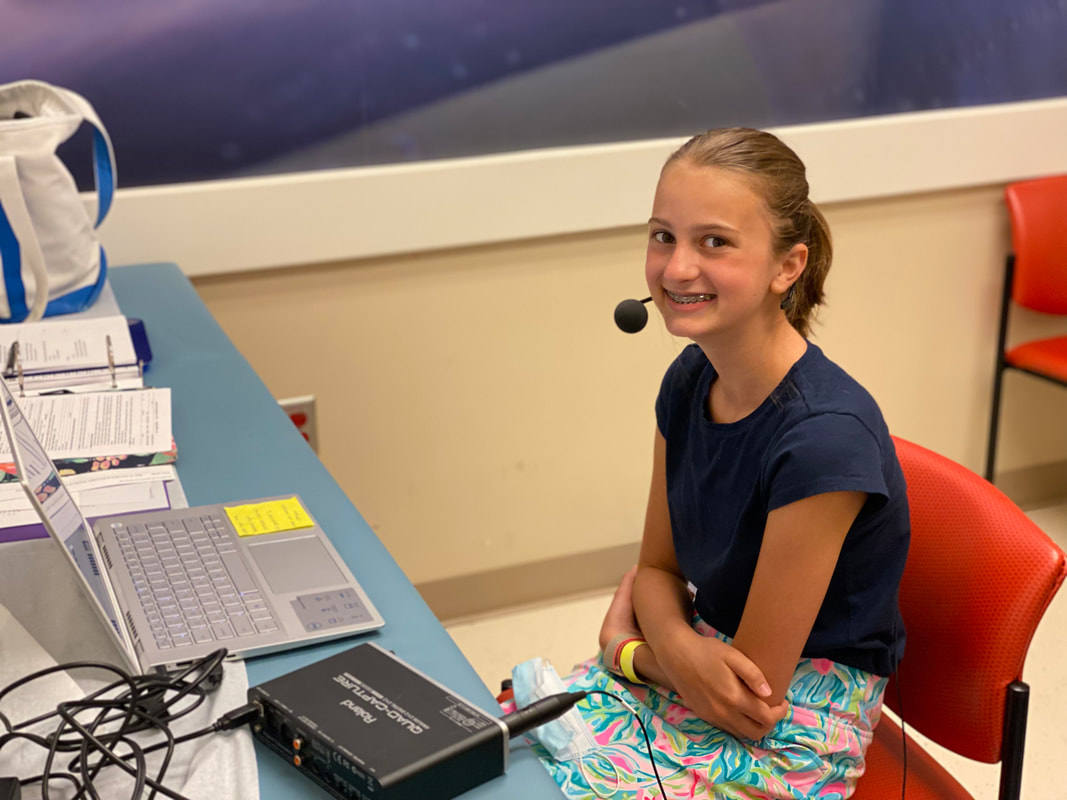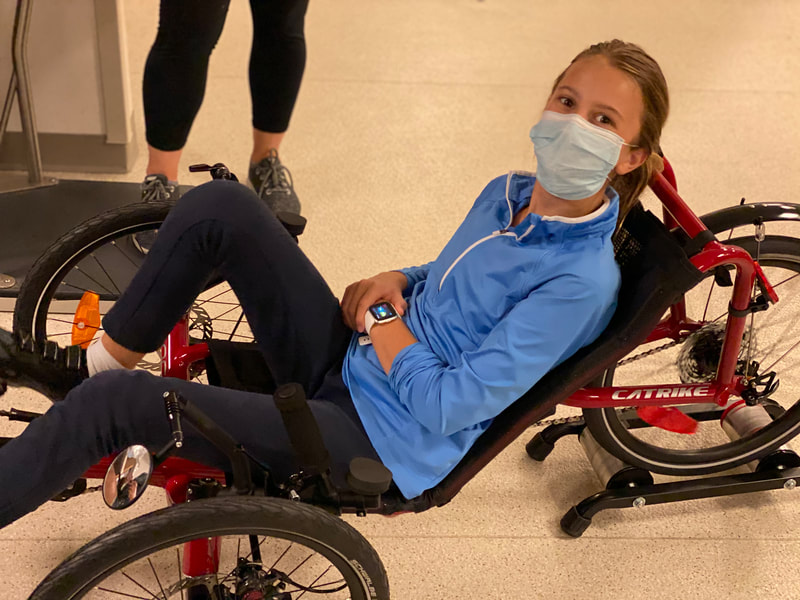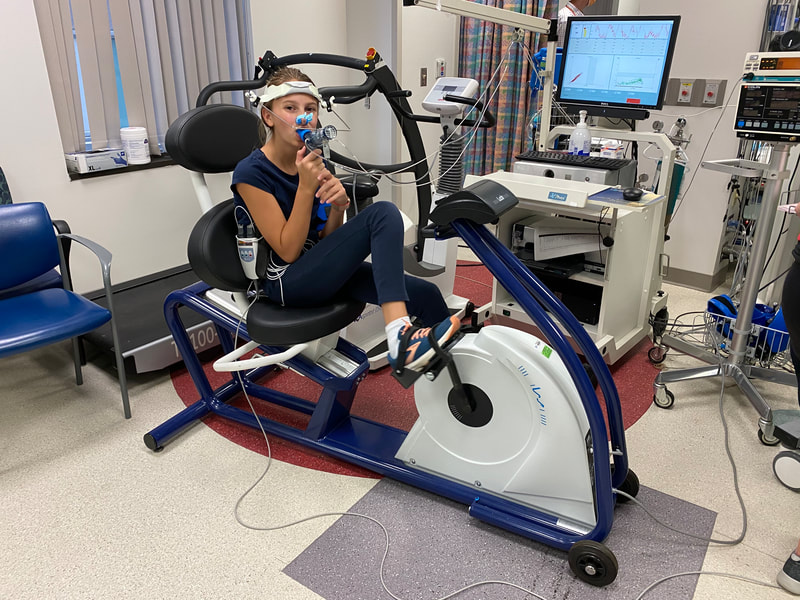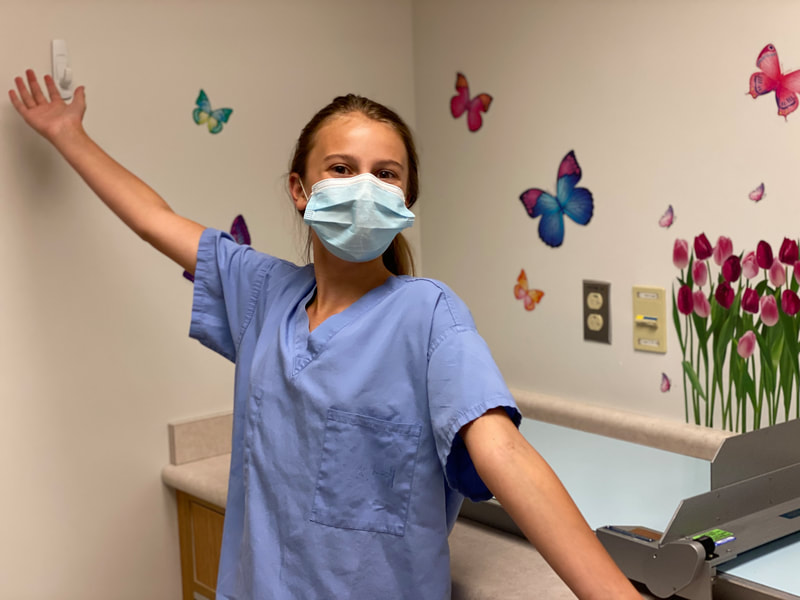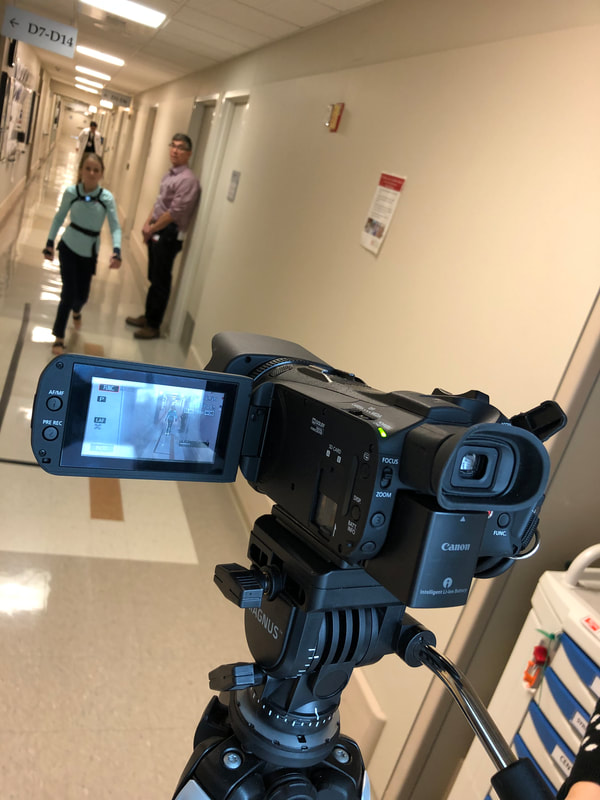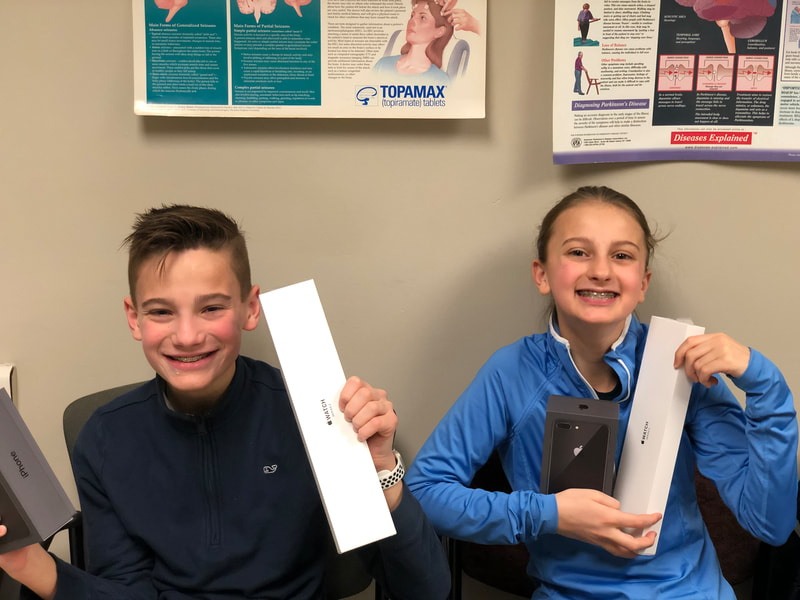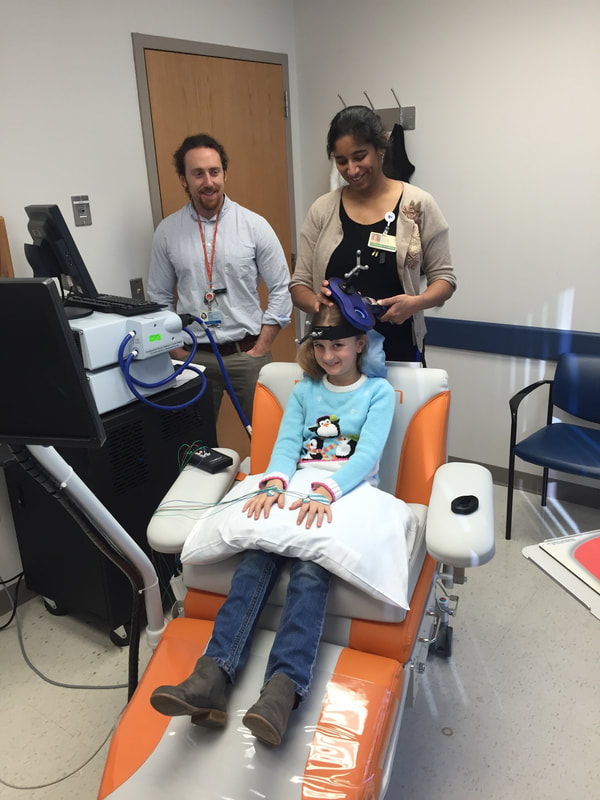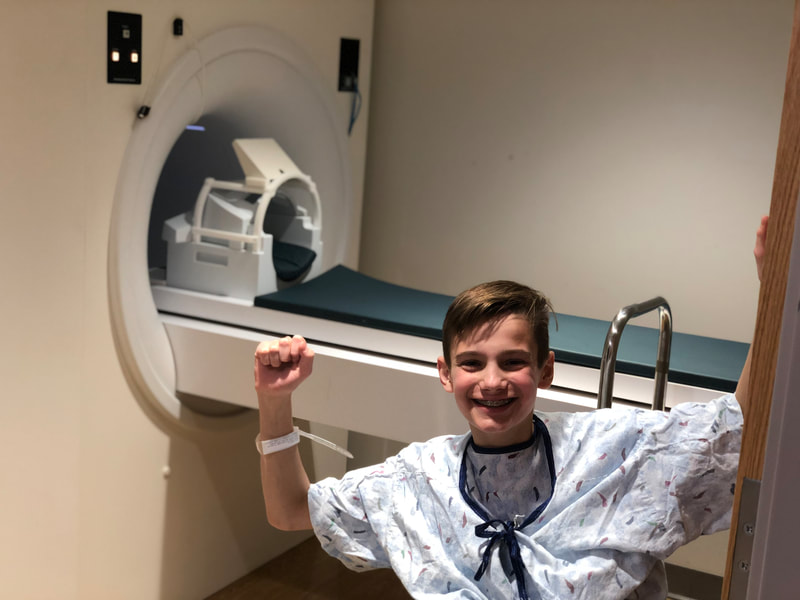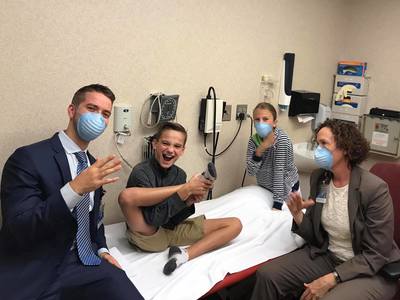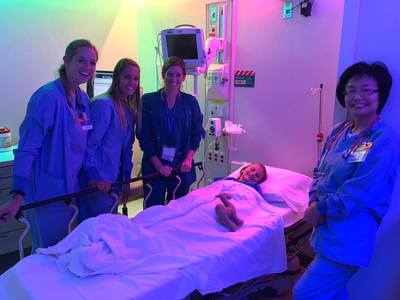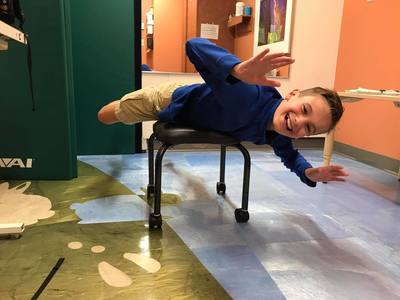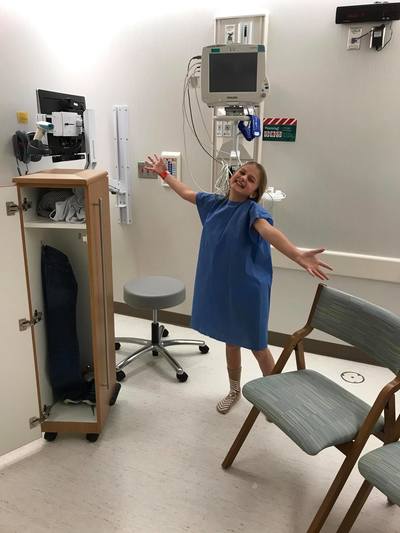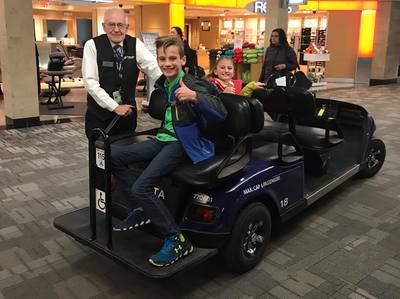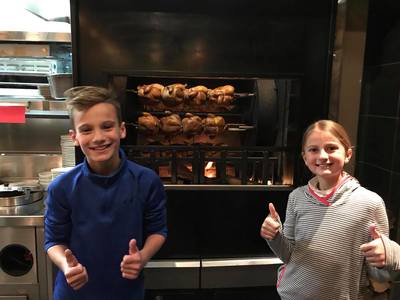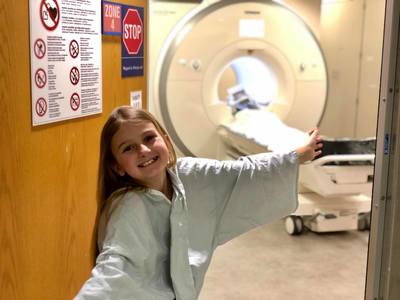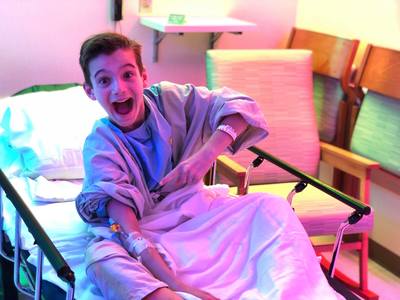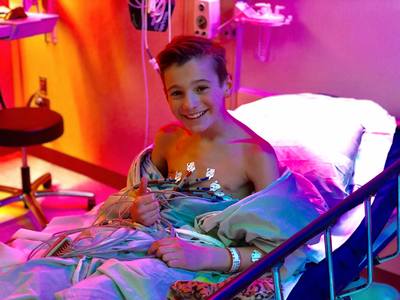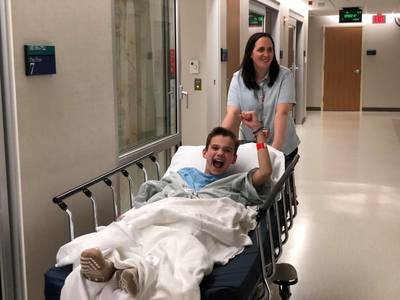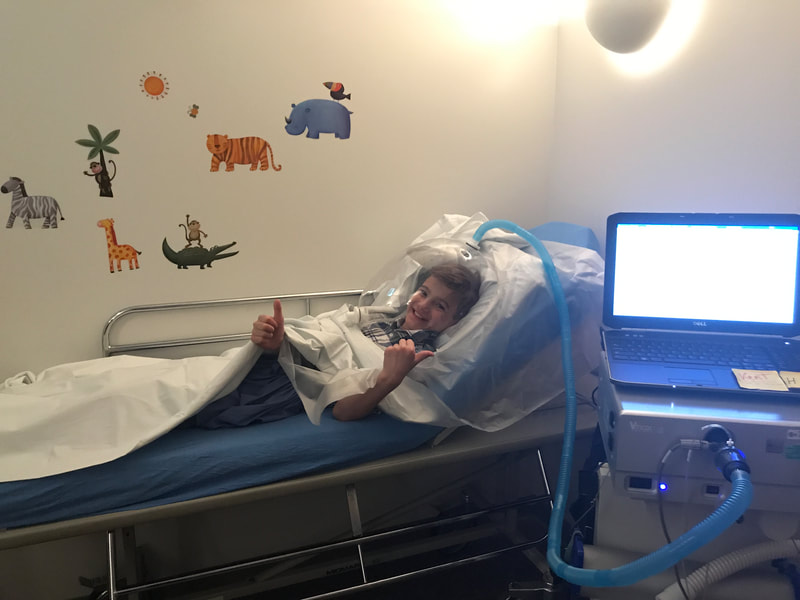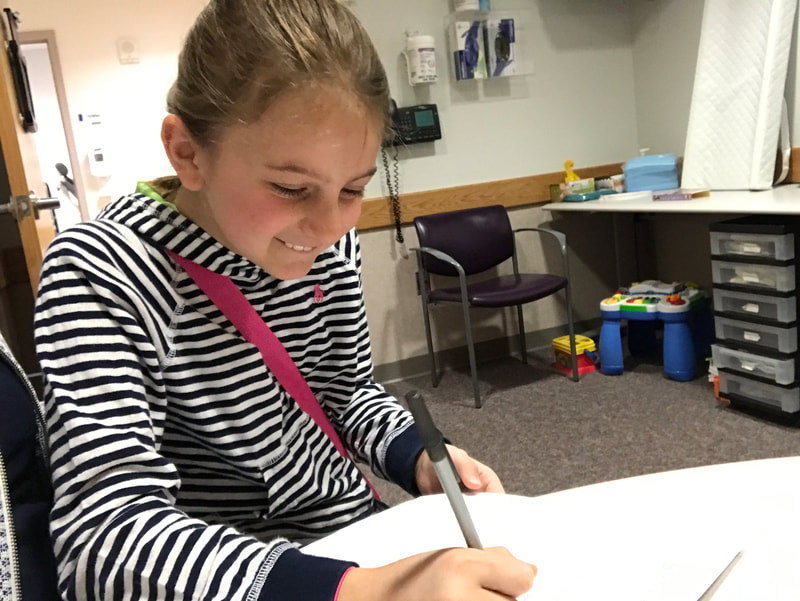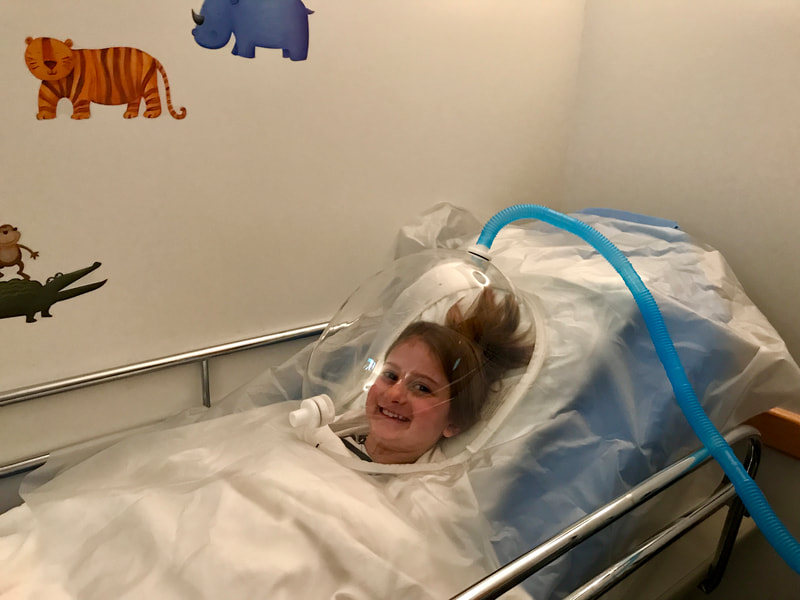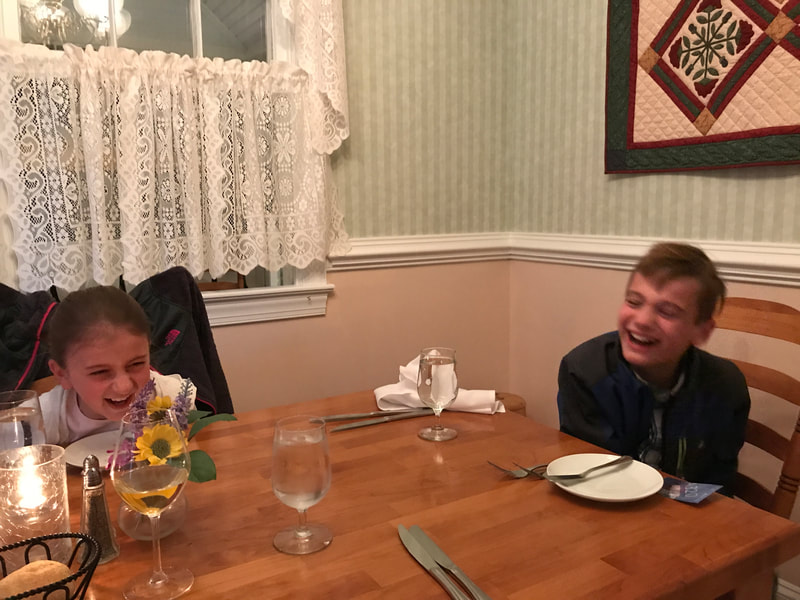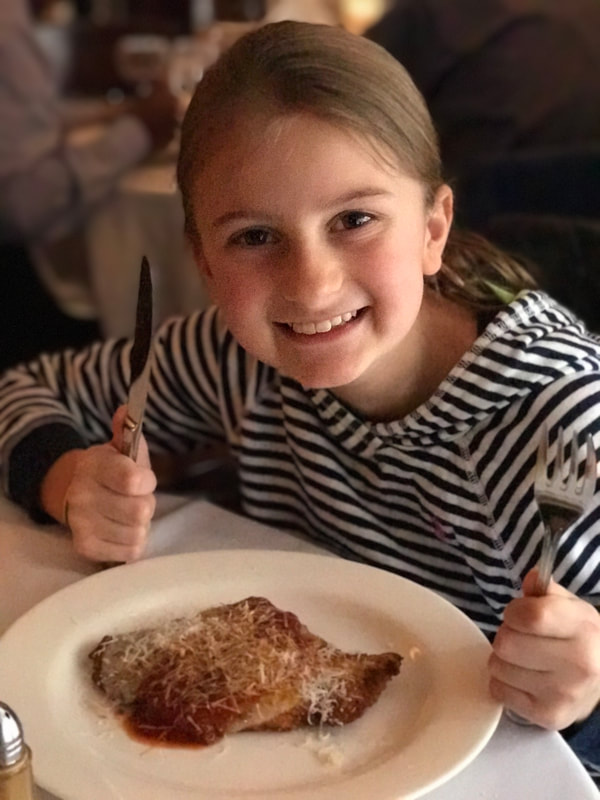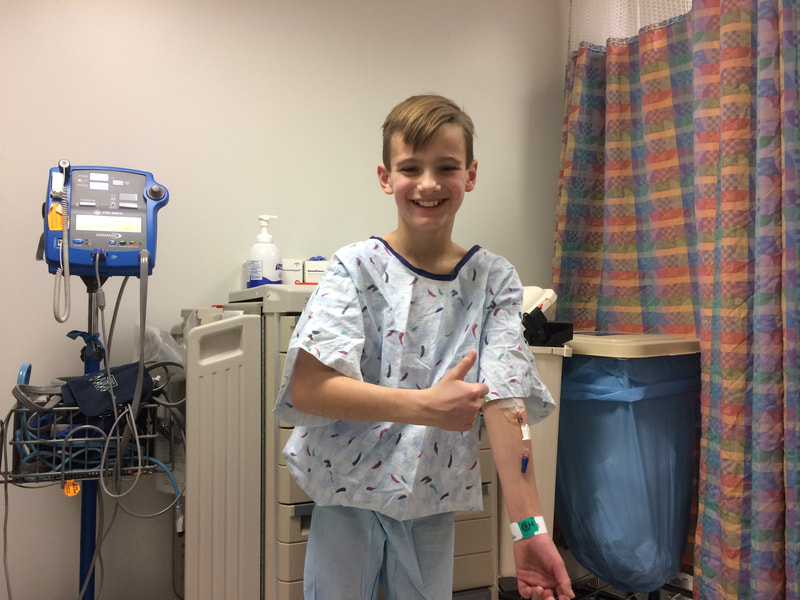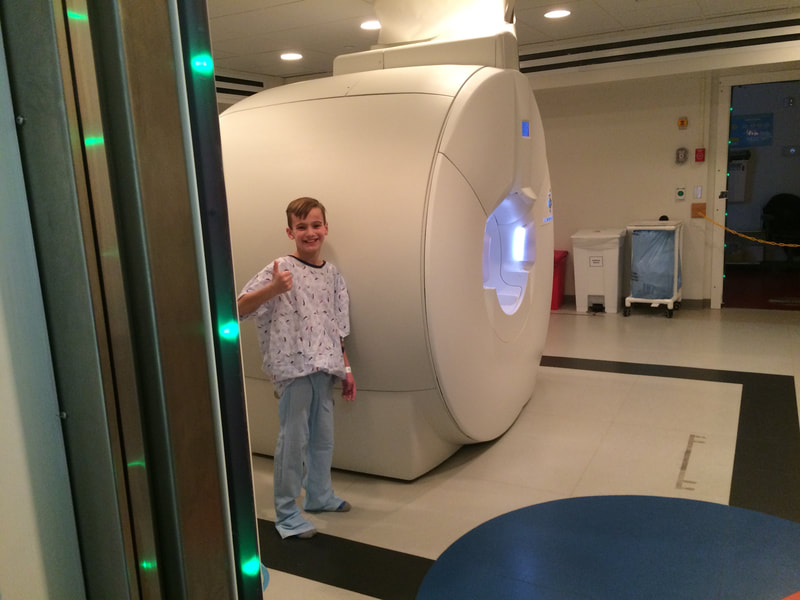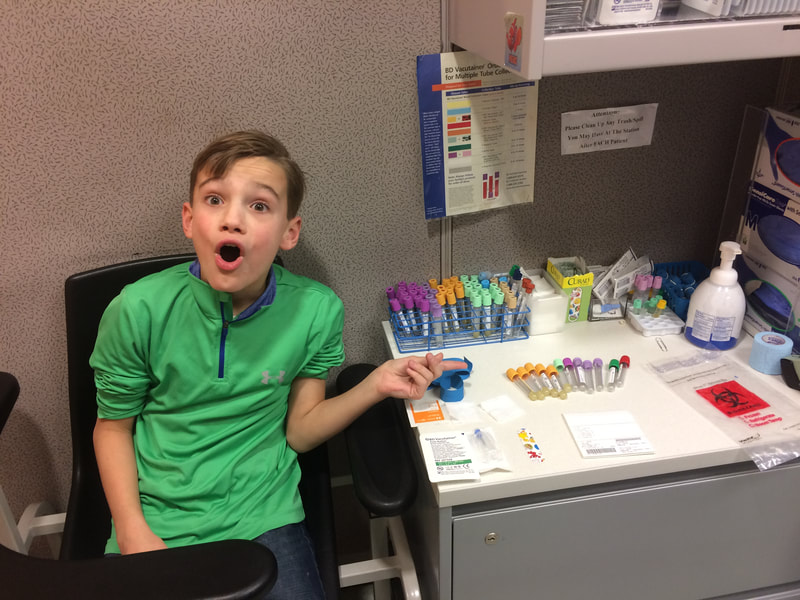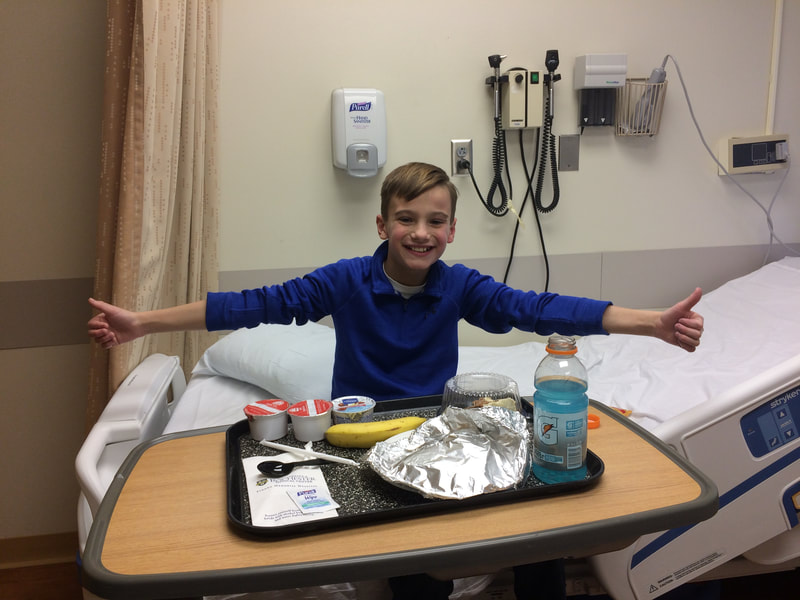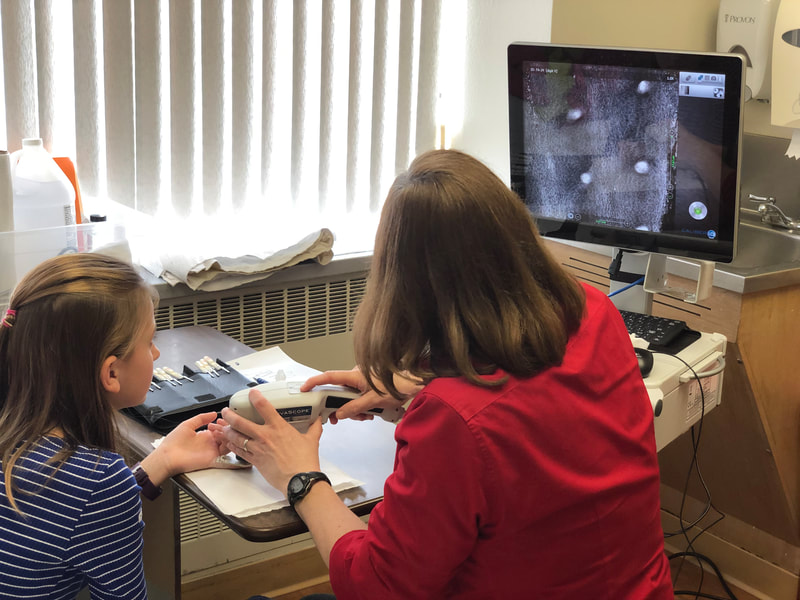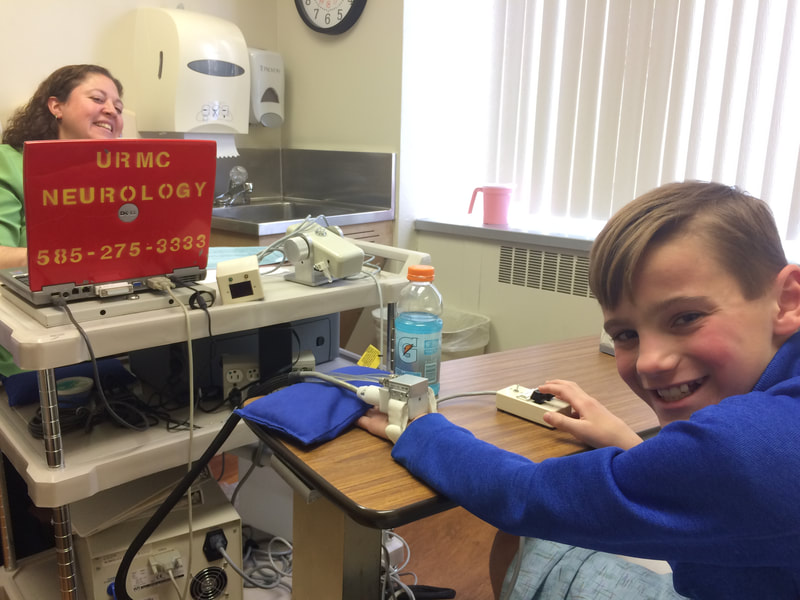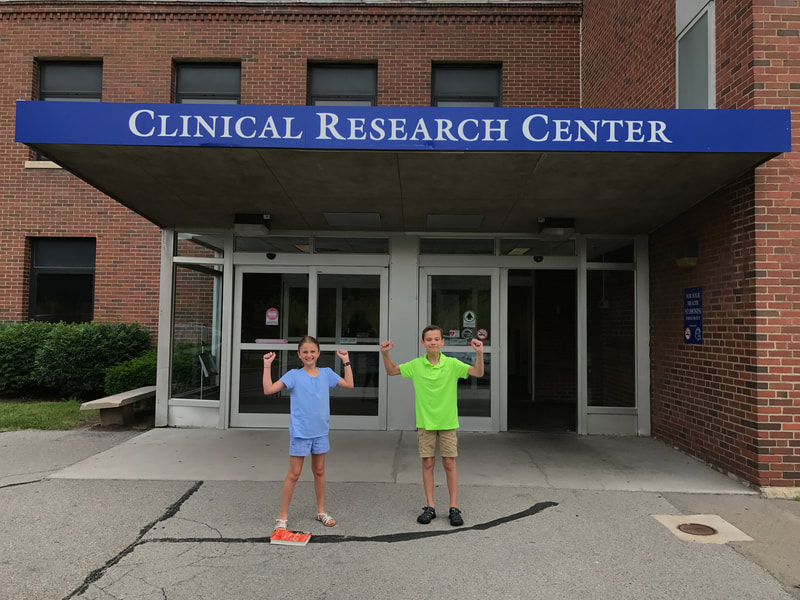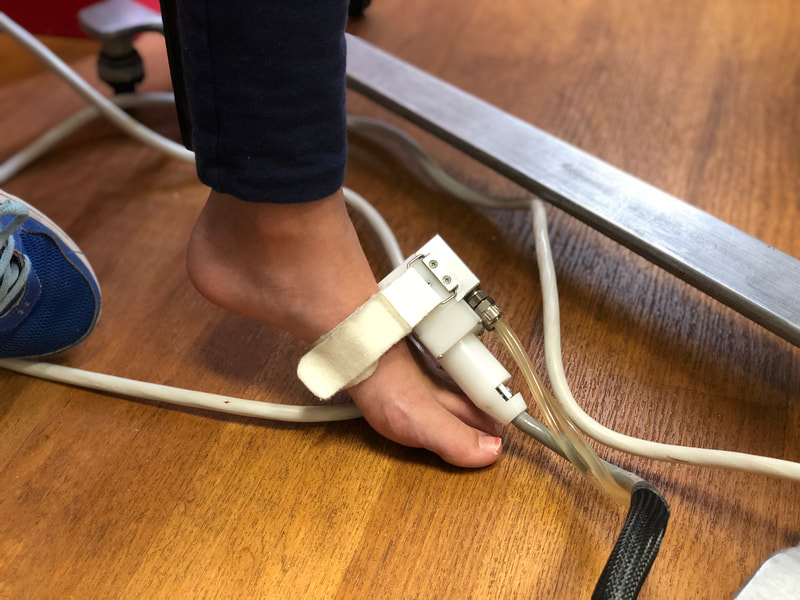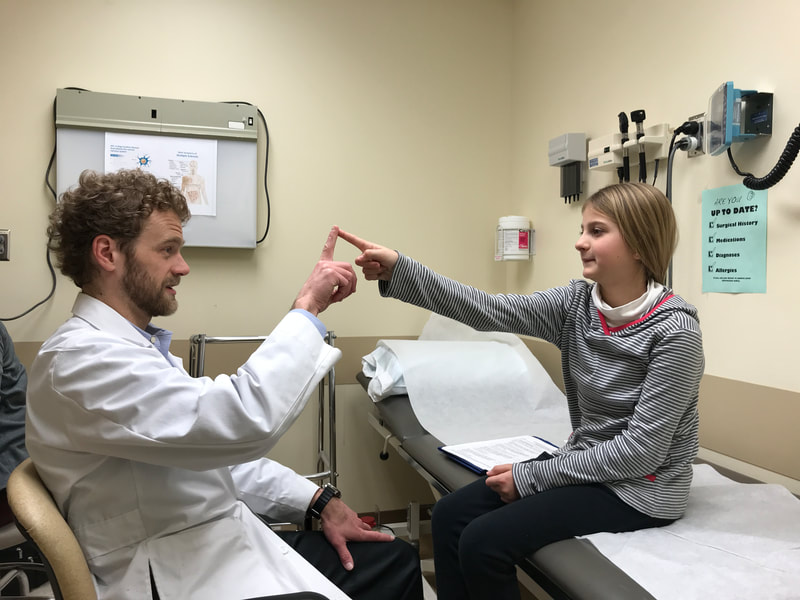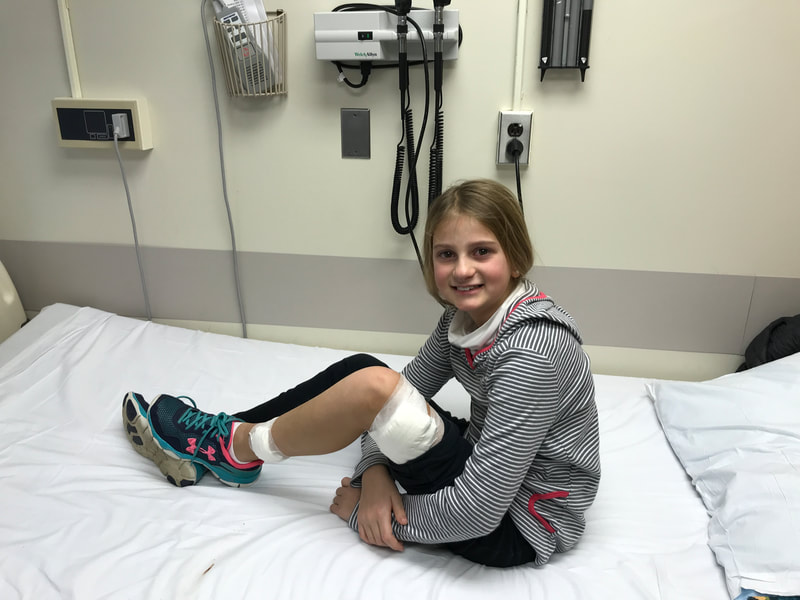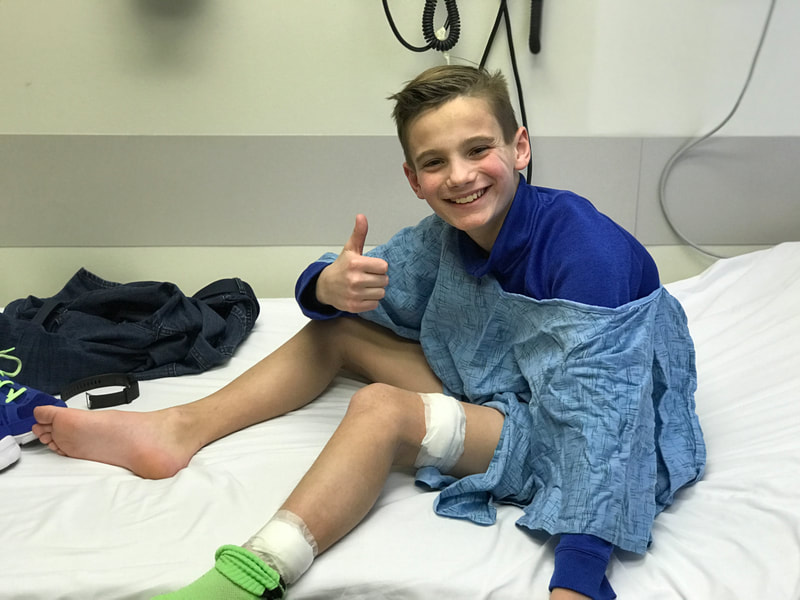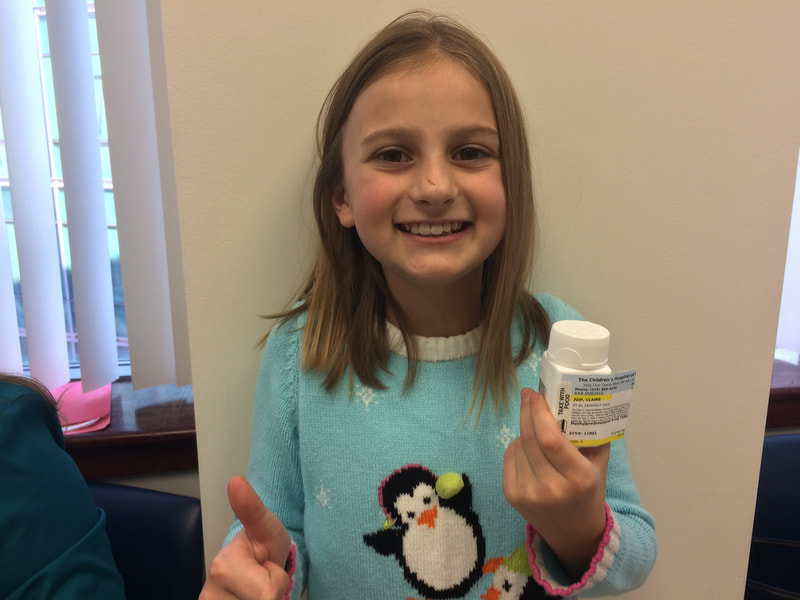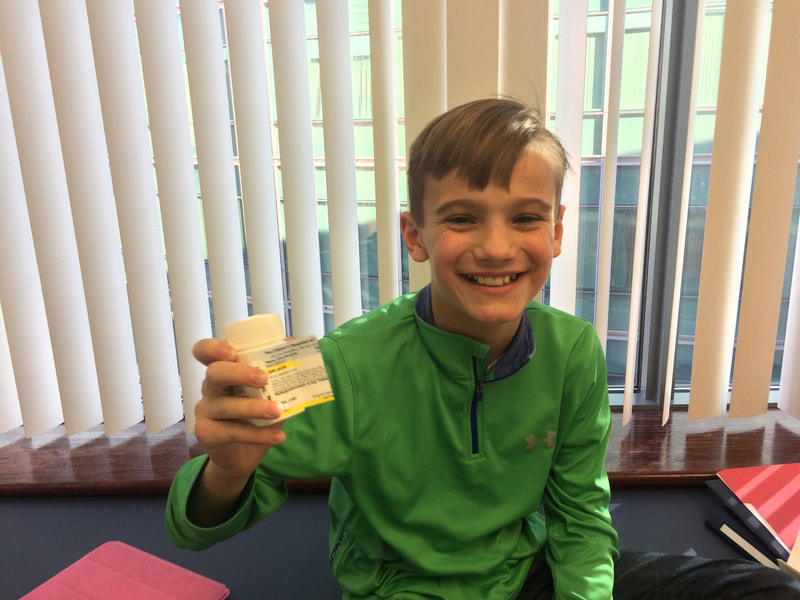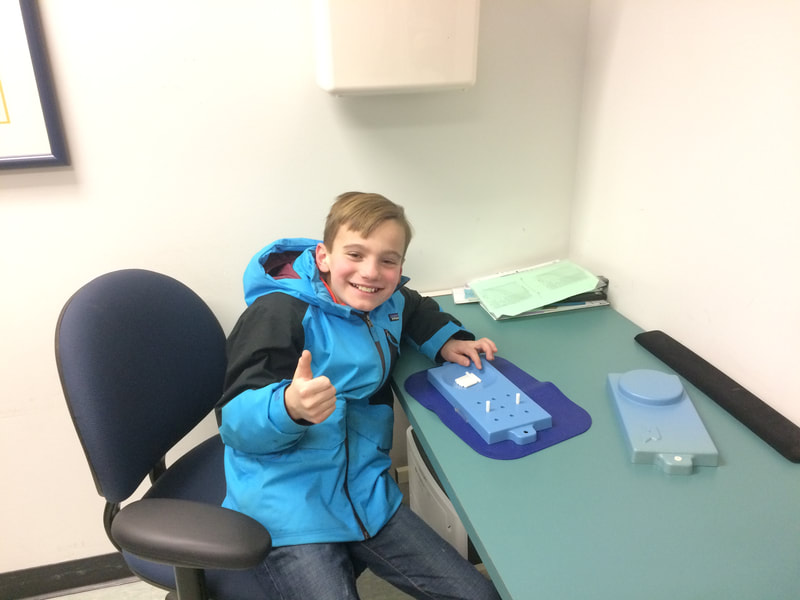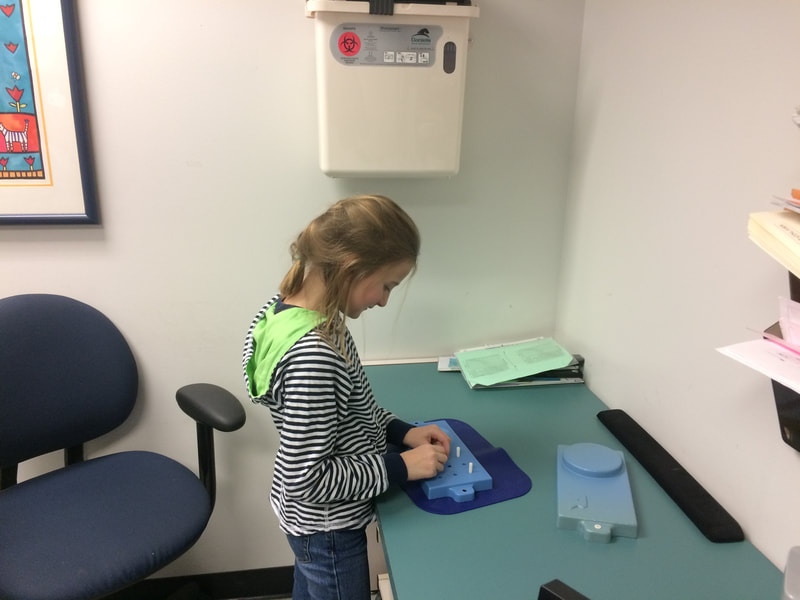Volunteering for Research
Jake & Claire have volunteered for clinical trials and biomarker research studies.
There are different goals for each. Both are important.
There are different goals for each. Both are important.
Biomarker StudiesBiomarker studies collect data about FA patients.
You don't take any medications when you are in a biomarker study. |
Clinical TrialsClinical trials test experimental treatments. Participants take medicines that researchers think might help. Then, they gather information about any changes or improvements in symptoms.
|
PTC-743 MOVE-FA Global Phase 3 Clinical Trial
2021, ongoing. Children's Hospital of Philadelphia.
Jake and Claire are both participating in the double-blind, placebo-controlled MOVE-FA study to evaluate the efficacy of vatiquinone. Normal cells create energy when frataxin chaperones iron and sulfur as they scaffold to build ATP. Because Jake and Claire don't make enough frataxin protein, their cells have extra iron. That iron builds up, creates oxidative stress, and the cells eventually die. Vatiquinone is an investigational small molecule that inhibits 15-Lipoxygenase, an enzyme that's a key regulator of this oxidative stress and the inflammation response pathways. It's been evaluated in a number of clinical studies, and it's shown to have an impact on mortality risk and a number of neurological disease symptoms. Moreover, in more than 500 patients with duration of exposure up to 10 years, vatiquinone has demonstrated a favorable safety profile. Are they taking active drug or placebo? We'll have to wait and see...
NAD+ and Exercise in Friedreich's Ataxia. Clinical Trial.
Sept-20 through Dec-20. Children's Hospital of Philadelphia.
There is currently no treatment and no cure for FA. Jake and Claire are focused on keeping themselves as strong as possible until a treatment or a cure can be found. Inspired by compelling research from the University of Virginia, researchers at CHOP are evaluating whether or not exercise itself might be an effective intervention for FA.
Thanks to the generosity of the NIH, Claire has a rigorous at-home exercise regimen. She does cardio exercises on a stationary Catrike 3x/week and strength training 2x/week. An exercise coach set a target heartrate for her cardio, and she tracks her heartrate with a Fitbit.
Simultaneously, she is taking a daily pill. This part of the study is double-blind, so she's either taking a placebo or a NAD+ (Nicotinamide Riboside) supplement.
*Jake was not eligible to participate in this trial because he's already exercising six days per week with his high school cross country team.
Thanks to the generosity of the NIH, Claire has a rigorous at-home exercise regimen. She does cardio exercises on a stationary Catrike 3x/week and strength training 2x/week. An exercise coach set a target heartrate for her cardio, and she tracks her heartrate with a Fitbit.
Simultaneously, she is taking a daily pill. This part of the study is double-blind, so she's either taking a placebo or a NAD+ (Nicotinamide Riboside) supplement.
*Jake was not eligible to participate in this trial because he's already exercising six days per week with his high school cross country team.
IDEA Study. Instrumented Data Exchange for Ataxia Study.
March 2020. Scheduled for 2 years, but Covid may impact timing. University of Chicago.
Pfizer and Biogen are interested in evaluating wearables as a valid way of measuring disease progression. Using a cool motion capture suit (like they use in Hollywood), the kids had a baseline visit that tracked their performance on the mFARS neurological test. Every two weeks, they put on an Apple Watch and a fanny pack harness for an iPhone, and they complete a series of mobility, fine motor, and speaking tests. Researchers will analyze this bi-weekly data and compare it to the in-person tests to see if the Apple Watch and iPhone provide reliable data about the status of disease.
Jake and Claire are really excited to participate because they get to keep the Apple Watch and iPhone at the end of the study!
Details about the study can be found here: https://clinicaltrials.gov/ct2/show/NCT04268147
Jake and Claire are really excited to participate because they get to keep the Apple Watch and iPhone at the end of the study!
Details about the study can be found here: https://clinicaltrials.gov/ct2/show/NCT04268147
Neurology Measures in FA Children. Biomarker Study.
Ongoing. Started in 2017. Children's Hospital of Philadelphia.
This study is very similar to the annual Natural History study, except this study is specifically for children. It's funded by the FDA, and it included the same tests like the mFARS, 9-hole peg test, 1 minute walk test, etc. However, it also included a Motor-Evoked Potential (MEP) test and a MRI of the calf muscle.
For the MEP, the researchers hold a wand over a specific area of the kids' heads. Without touching the head, they generate an impulse. It travels through the nerves and causes a small involuntary movement in their dominant head. It's fascinating to watch. The kids are always surprised to see their hand moving. The MEP measures how strong the connection is between the brain’s motor cortex and the hand.
They also have an MRI of their calf. For this test, they are asked to push a pedal repeatedly while in the MRI. The MRI scan looks at how FA affects muscle activity.
Details of the study can be found here:
https://clinicaltrials.gov/ct2/show/NCT03418740?recrs=a&cond=Friedreich+Ataxia&age=0&draw=4&rank=4
For the MEP, the researchers hold a wand over a specific area of the kids' heads. Without touching the head, they generate an impulse. It travels through the nerves and causes a small involuntary movement in their dominant head. It's fascinating to watch. The kids are always surprised to see their hand moving. The MEP measures how strong the connection is between the brain’s motor cortex and the hand.
They also have an MRI of their calf. For this test, they are asked to push a pedal repeatedly while in the MRI. The MRI scan looks at how FA affects muscle activity.
Details of the study can be found here:
https://clinicaltrials.gov/ct2/show/NCT03418740?recrs=a&cond=Friedreich+Ataxia&age=0&draw=4&rank=4
Epicatechin Clinical Trial. Mayo Clinic.
Sept-2017 through Feb-2018. Rochester, MN.
Epicatechin is a compound found in dark chocolate and red wine. For this trial, it was highly concentrated. Researchers think it might help improve mitochondrial function - especially in the heart.
At their first visit in September 2017, Jake and Claire did baseline MRIs of their brain and spine, plus a cardiac MRI with stress. They had an echocardiogram, and they were evaluated by a neurologist, physical medicine doctor, physical therapist, and occupational therapist. They also did a glucose test and had lots of blood drawn.
We left the first visit with a cooler full of the epicatechin, and the kids started taking the pills three times a day. We set a timer on my phone, and when they heard the tune, they went to the refrigerator and take the next dose.
We visited mid-study around Thanksgiving 2017 for a short visit. At this visit, they were evaluated by all of the same specialists, but they only had a non-stress cardiac MRI. They also had more blood drawn.
The researchers had the option to increase the dose of epicatechin or keep it at the baseline. After evaluating the results of this halfway visit, the dose remained the same. We left with a refilled cooler of the rest of the study drug.
Our final visit was February 2018. All of the same tests from the first visit were repeated. The kids stopped taking the study drug, and now we wait.
In July 2020, researchers published the results of the study. https://onlinelibrary.wiley.com/doi/10.1002/jimd.12285
It was a small study, but the data showed improvement of cardiac function. There was an improvement in the FARS/mFARS scores, but it was not statistically significant. Also, there was sustained significant upregulation of muscle‐regeneration biomarker follistatin.
At their first visit in September 2017, Jake and Claire did baseline MRIs of their brain and spine, plus a cardiac MRI with stress. They had an echocardiogram, and they were evaluated by a neurologist, physical medicine doctor, physical therapist, and occupational therapist. They also did a glucose test and had lots of blood drawn.
We left the first visit with a cooler full of the epicatechin, and the kids started taking the pills three times a day. We set a timer on my phone, and when they heard the tune, they went to the refrigerator and take the next dose.
We visited mid-study around Thanksgiving 2017 for a short visit. At this visit, they were evaluated by all of the same specialists, but they only had a non-stress cardiac MRI. They also had more blood drawn.
The researchers had the option to increase the dose of epicatechin or keep it at the baseline. After evaluating the results of this halfway visit, the dose remained the same. We left with a refilled cooler of the rest of the study drug.
Our final visit was February 2018. All of the same tests from the first visit were repeated. The kids stopped taking the study drug, and now we wait.
In July 2020, researchers published the results of the study. https://onlinelibrary.wiley.com/doi/10.1002/jimd.12285
It was a small study, but the data showed improvement of cardiac function. There was an improvement in the FARS/mFARS scores, but it was not statistically significant. Also, there was sustained significant upregulation of muscle‐regeneration biomarker follistatin.
DEXA (Bone Strength) & REE (Resting Energy Expenditure) Biomarker Study
April 2016. Children's Hospital of Philadelphia
FA'ers typically have either very low BMIs or very high BMIs. Researchers are interested in understanding this better. So, they conducted an imaging study designed to assess body habitus and composition in patients with FA.
This study was really fun for the kids! For dinner on the night before their study, they got to pick any restaurant in Philly and choose a meal from their menu. Then, a nutrition growth specialist called the restaurant to calculate the nutritional content of the food they picked. She coordinated serving sizes with the restaurants - fortunately, both restaurants that the kids picked were very accommodating and happy to help. Their pre-study meals were as follows:
Jake: The Restaurant School
½ cup Broccoli salad (if they could go a little lite on the dressing)
Pork Chop (1 chop = ~3 ½ ounces )
½ cup root vegetable
¼ cup applesauce
1 slice bread (no butter or olive oil)
Chocolate peanut butter torte: Size is equal to ~1/2 medium cupcake (includes the caramel and chocolate sauce)
Water
CLAIRE: Dante & Luigi's
½ cup tossed salad with tomatoes, dressing, olive
½ chicken parmigiana breast – includes cheese, sauce, chicken (it comes out to ~5 ¾ ounces)
1/3 cup fettucine alfredo
1 ½ slices Italian bread
¾ medium cupcake size chocolate fudge cake
¼ cup ice cream
Water
After eating this strict diet, they got as much rest as possible that night. Then, they arrived at the hospital early in the morning and laid on a table (watching a movie) for an hour while bioenergists studied their resting metabolic features. Then, they had a dual x-ray absorptiometry (DXA) scans of the whole body. This was a 15 minute non-invasive procedure that measured fat, muscle, and bone distribution.
This study was really fun for the kids! For dinner on the night before their study, they got to pick any restaurant in Philly and choose a meal from their menu. Then, a nutrition growth specialist called the restaurant to calculate the nutritional content of the food they picked. She coordinated serving sizes with the restaurants - fortunately, both restaurants that the kids picked were very accommodating and happy to help. Their pre-study meals were as follows:
Jake: The Restaurant School
½ cup Broccoli salad (if they could go a little lite on the dressing)
Pork Chop (1 chop = ~3 ½ ounces )
½ cup root vegetable
¼ cup applesauce
1 slice bread (no butter or olive oil)
Chocolate peanut butter torte: Size is equal to ~1/2 medium cupcake (includes the caramel and chocolate sauce)
Water
CLAIRE: Dante & Luigi's
½ cup tossed salad with tomatoes, dressing, olive
½ chicken parmigiana breast – includes cheese, sauce, chicken (it comes out to ~5 ¾ ounces)
1/3 cup fettucine alfredo
1 ½ slices Italian bread
¾ medium cupcake size chocolate fudge cake
¼ cup ice cream
Water
After eating this strict diet, they got as much rest as possible that night. Then, they arrived at the hospital early in the morning and laid on a table (watching a movie) for an hour while bioenergists studied their resting metabolic features. Then, they had a dual x-ray absorptiometry (DXA) scans of the whole body. This was a 15 minute non-invasive procedure that measured fat, muscle, and bone distribution.
Cardiac MRI Biomarker Study.
Official Title: Interstitial Fibrosis, the Renin-Angiotensin-Aldosterone
System and Biomarkers in the Cardiac Disease of Friedreich Ataxia
January 2017. Children's Hospital of Philadelphia.
Claire wasn't old enough to participate, but Jake was one of the last subjects to enroll in a cardiac MRI biomarker study.
The purpose of this study was to learn more about how Friedreich's Ataxia affects patients' hearts. Jake had an electrocardiogram, a MRI with contrast, frataxin measurements via cheek swab sampling, and blood tests.
The purpose of this study was to learn more about how Friedreich's Ataxia affects patients' hearts. Jake had an electrocardiogram, a MRI with contrast, frataxin measurements via cheek swab sampling, and blood tests.
In-vivo Confocal Imaging of Meissner's Corpuscles Biomarker Study
Dec-2016 through Jun-2018. University of Rochester (NY). 4 Visits.
Researchers would like to find non-invasive biomarkers that indicate the progression of FA. One idea is to measure the Meissner's Corpuscles in FA'ers finger and toes. To verify whether or not this is a valid biomarker, Jake and Claire visited the University of Rochester every 6 months for two years. Over this time, they tracked the progression of the disease and the correlation to their Meissner corpuscles.
There were a variety of tests, including filament tests, hot/cold sensing, the mFARS, and a skin biopsy.
The results of the first phase of the study can be found here: https://www.ncbi.nlm.nih.gov/pmc/articles/PMC6764626/
There were a variety of tests, including filament tests, hot/cold sensing, the mFARS, and a skin biopsy.
The results of the first phase of the study can be found here: https://www.ncbi.nlm.nih.gov/pmc/articles/PMC6764626/
Methylprednisolone Clinical Trial
Dec-2016 through June-2017. Children's Hospital of Philadelphia.
Methylprednisolone is a very common steroid. It's routinely given to children and adults to help with both chronic and acute issues. Anecdotally, FA'ers reported feeling stronger and more stable when they were on a course of steroids. This trial investigated the impact of on children with Friedreich's Ataxia.
This was an open-label study that included 5 children. This means that all 5 children knew they were receiving the methylprednisolone.
The kids took a dose pack of the steroid as follows: 48 mg methylprednisolone at day 1 with the dose decreasing by 8 mg per day. After 6 days, they spent 22 days off medication before repeating the same treatment cycle. This regimen continued for six months.
We traveled to CHOP at weeks 2, 6, 14, 26, and 30.
The study found that methylprednisolone is well-tolerated in FA children. The children did improve the distance they walked in the 1-minute walk test, but no other measures showed improvement. Study results can be found here: https://pubmed.ncbi.nlm.nih.gov/31206761/
This was an open-label study that included 5 children. This means that all 5 children knew they were receiving the methylprednisolone.
The kids took a dose pack of the steroid as follows: 48 mg methylprednisolone at day 1 with the dose decreasing by 8 mg per day. After 6 days, they spent 22 days off medication before repeating the same treatment cycle. This regimen continued for six months.
We traveled to CHOP at weeks 2, 6, 14, 26, and 30.
The study found that methylprednisolone is well-tolerated in FA children. The children did improve the distance they walked in the 1-minute walk test, but no other measures showed improvement. Study results can be found here: https://pubmed.ncbi.nlm.nih.gov/31206761/
Natural History Study
Ongoing. Started in December 2016. Children's Hospital of Philadelphia. Biomarker Study.
One of the most important things that FARA has done to push FA research forward is their Natural History Study. For more than a decade, FA clinicians across the globe have been following FA'ers on an annual basis. They conduct the same series of neurological tests called the mFARS, and they gain a better understanding of how function declines as Friedreich's Ataxia takes its natural course.
Jake and Claire join 1,000+ patients who have volunteered for this study.
The data from this study is critically important for our industry partners who are working on therapies. By understanding the expected progression of the disease, they can compare how their therapy slows or reverses the natural course of the disease.
Dr. David Lynch administers this study at CHOP, and he's an outstanding physician who the kids genuinely look forward to seeing.
Jake and Claire join 1,000+ patients who have volunteered for this study.
The data from this study is critically important for our industry partners who are working on therapies. By understanding the expected progression of the disease, they can compare how their therapy slows or reverses the natural course of the disease.
Dr. David Lynch administers this study at CHOP, and he's an outstanding physician who the kids genuinely look forward to seeing.


